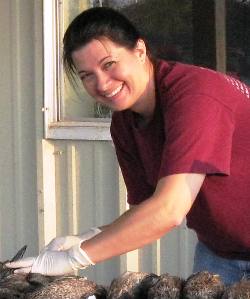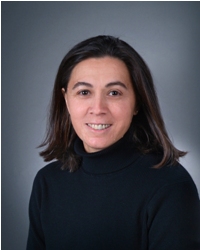Ferro Studied AIV in Migratory Birds on Texas Gulf Coast
The Texas Gulf Coast provides a wonderful escape for migratory birds during the winter. Residents and hunters off of the Texas Gulf Coast enjoy the waterfowls’ annual visit, but people need to be aware of the impact waterfowl may have due to the viruses they carry. Dr. Pam Ferro, who received her Ph.D. in veterinary pathobiology from Texas A&M College of Veterinary Medicine & Biomedical Sciences (CVM) in August, spent five consecutive years studying avian influenza viruses (AIV) in hunter-harvested waterfowl in the wintering grounds off of the Texas Gulf Coast.
 In North America there are four major flyways: the Pacific, the Central, the Mississippi, and the Atlantic. Ferro chose to study the wintering grounds of the Central flyway because it is the most understudied out of the four. The Texas Gulf Coast was a great place to focus for Ferro, because approximately 90 percent of waterfowl that use the Central flyway winter in Texas.
In North America there are four major flyways: the Pacific, the Central, the Mississippi, and the Atlantic. Ferro chose to study the wintering grounds of the Central flyway because it is the most understudied out of the four. The Texas Gulf Coast was a great place to focus for Ferro, because approximately 90 percent of waterfowl that use the Central flyway winter in Texas.
The objective of Ferro’s study was to determine the prevalence of AIV on waterfowl wintering grounds on the Texas Gulf Coast because waterfowl are considered the natural reservoir for AIV. These viruses can be transmitted to humans and poultry because migratory waterfowl intermingle with resident wild species and they are also in close contact with poultry operations and humans, primarily hunters. The infected migratory birds shed the virus through their feces. Infection with influenza virus in humans and chickens results mainly in a respiratory disease.
“The migratory nature of many waterfowl species and the persistence of influenza in these populations present a vehicle for dissemination of influenza viruses globally,” explained Ferro. “Understanding the migratory patterns of different waterfowl as well as identifying influenza virus subtypes within these populations is critical to our understanding of how influenza viruses persist in nature and evolve over time.”
“The reason for the study was to see what kind of viruses are found on the Texas Gulf Coast because this area has not been well studied,” said Ferro. “Throughout the study, we did not find any highly pathogenic avian influenza viruses and we isolated over 150 viruses of very different subtypes. Now we are interested in comparing viruses that we isolated on the Texas Gulf Coast to the viruses that were isolated in the breeding grounds up North to see if there are any similarities.”
“We can’t eliminate the virus from the waterfowl,” Ferro said. “However, by knowing more about what occurs in nature we can develop control measures so these viruses won’t be transmitted to humans or poultry. If we can narrow down certain viruses that are highly prevalent at certain times we can enact bio-containment strategies on farms and surrounding areas to prevent infection.”
 Ferro’s research was under the direction of Dr. Blanca Lupiani, associate professor in the department of veterinary pathobiology at the CVM. Lupiani thought Ferro’s research project was a success because of significance of the data obtained as well as the collaborative effort that was present throughout the entire project.
Ferro’s research was under the direction of Dr. Blanca Lupiani, associate professor in the department of veterinary pathobiology at the CVM. Lupiani thought Ferro’s research project was a success because of significance of the data obtained as well as the collaborative effort that was present throughout the entire project.
Ferro collaborated with students from different colleges at Texas A&M University and enlisted the help of Texas Parks and Wildlife biologists and technicians as well as local hunters to make her research efforts possible. Ferro and her team collected over 7,000 cloacal swab samples from approximately 33 different potential host species.
“This was a wonderful research project,” Lupiani said. “Pam brought a group of people together with such a variety of expertise to help understand a complex problem. Her interdisciplinary approach built great relationships which resulted in great findings.”
“This was an amazing experience,” said Ferro. “It was a big learning curve for me since my background is not in ecology. I was able to get out in the field, work with a wide variety of individuals, got the chance to educate people about AIV in waterfowl, and I had the opportunity to experiment in the lab.”
Ferro is currently working as a post-doctoral research associate at the Southeastern Cooperative Wildlife Disease Study in Athens, Georgia.
This project was funded by the USDA and the Avian Influenza Coordinated Agricultural Projects (AICAP and AICAP 2).


